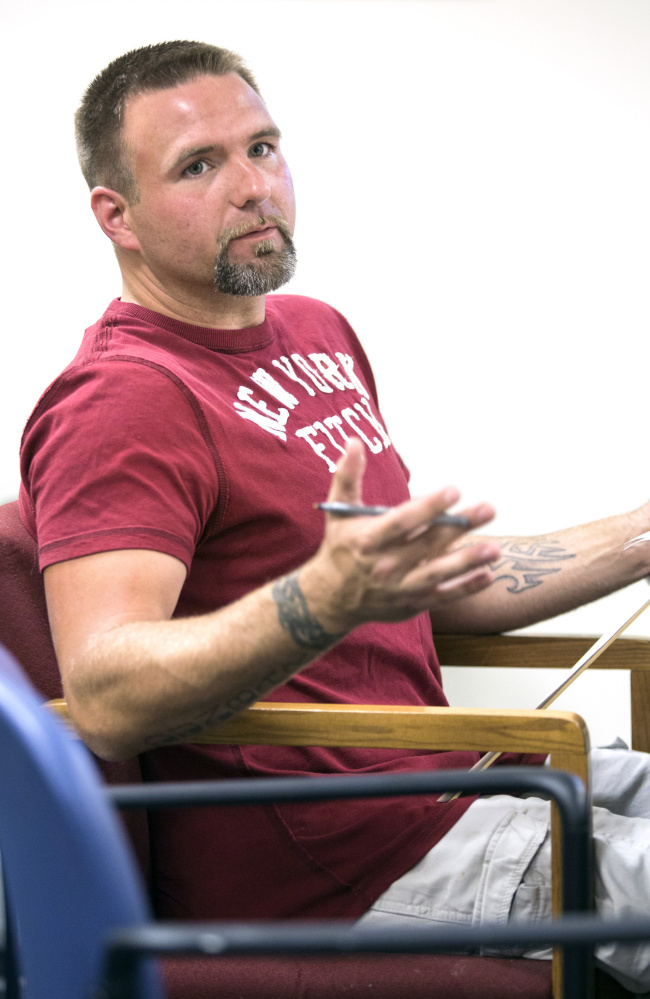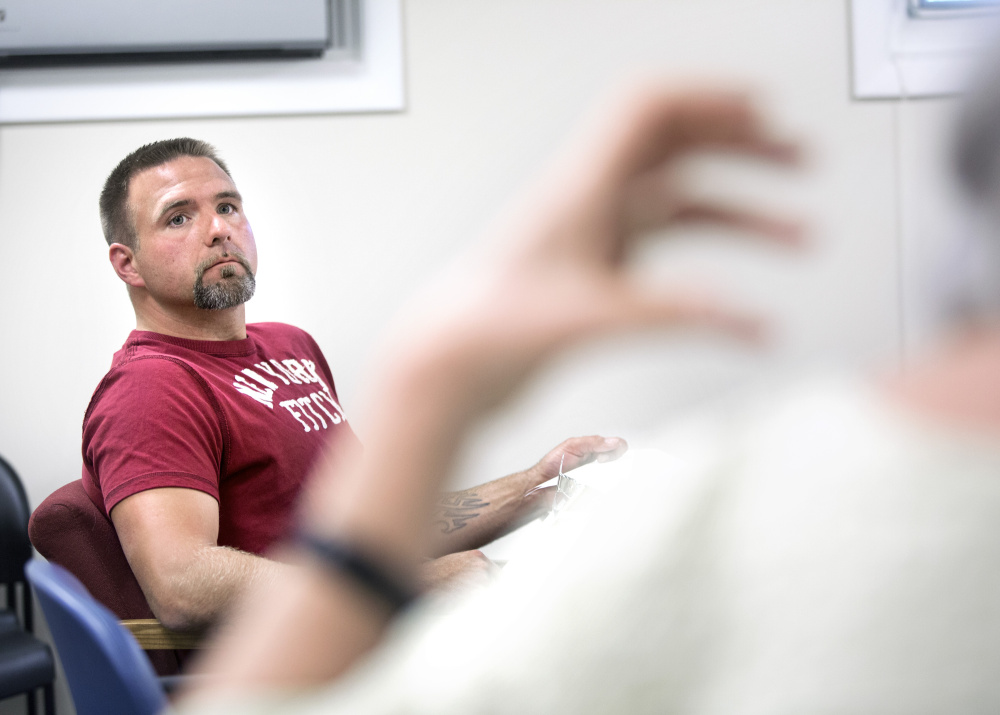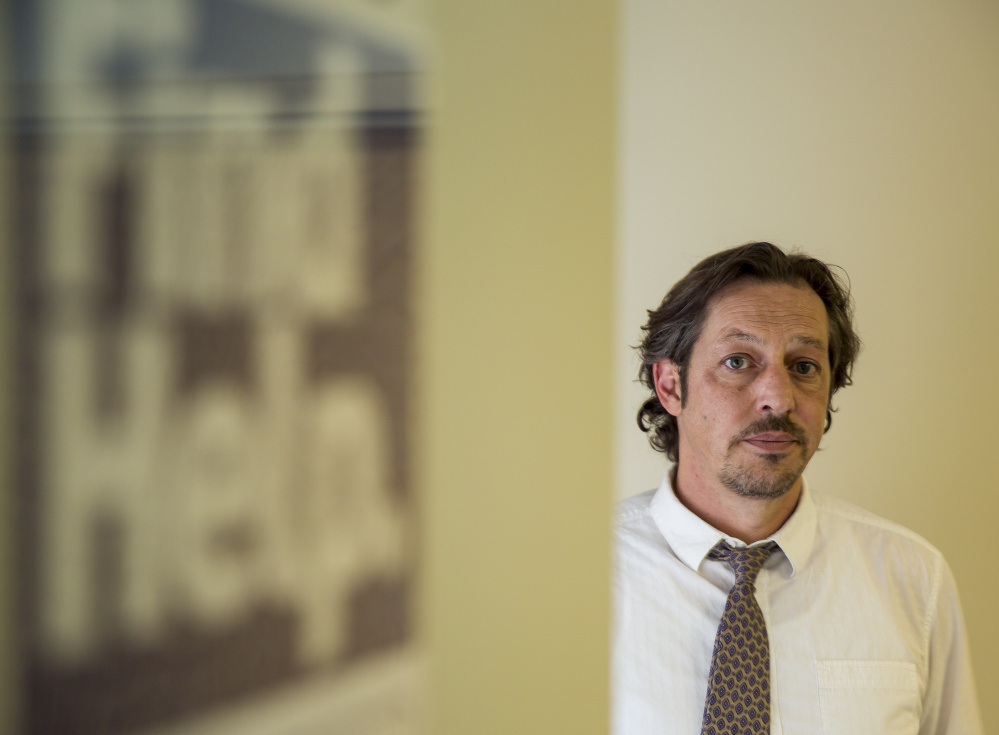BRUNSWICK — Scott Dunbar – homeless, uninsured and addicted to opioids – was desperate to get into a drug treatment program this spring after he had relapsed. He called dozens of programs, but couldn’t find any place that would accept him that didn’t have a lengthy waiting list.
But when he contacted the Addiction Resource Center in Brunswick, he was told they would immediately enroll him into a medication-assisted treatment program.
The center’s open access to drug treatment – those suffering from addiction can typically get into the ARC within two to three days – is almost unheard of in Maine. The center also has no waiting list, even for the uninsured who can’t pay out-of-pocket, again defying the typical experience.
Between 20,000 and 30,000 Mainers want access to drug treatment but are unable to get into programs, according to the U.S. Centers for Disease Control and Prevention.
The ARC system that allows quick and easy access into treatment is being touted as a potential key to alleviating Maine’s heroin crisis.
Perhaps part of the solution to the opioid epidemic was right here in Maine all along, under our collective noses, advocates say.
For instance, there were zero or very few drug overdose deaths in the Bath/Brunswick region in 2015, at the same time that overdoses were soaring through the rest of the state.
While it’s unproven that the ARC program is the reason for such low mortality by drug overdoses in the region, advocates wonder whether it’s more than a coincidence.
Meanwhile, treatment advocates and Mary Mayhew, Maine’s health and human services commissioner, are looking at whether the Brunswick program – or elements of it – can be replicated throughout the state.
While Maine waits for a solution, people in the throes of addiction who learn about the ARC are doing whatever it takes to show up for treatment in Brunswick.
Dunbar – who lives in Sullivan, nearly a three-hour drive from the ARC’s offices – needed to think of a creative solution if he wanted immediate help, once he was told he could enroll in the program.
So Dunbar, 32, scrounged up money for a bus ticket and, with the approval of the Brunswick Police Department, pitched a tent near the Thornton Trail in April. He was in a treatment program within three days of calling the ARC, an arm of Mid Coast Hospital in Brunswick.
“They said they could get me in right now, and the only way we could do that is to pitch a tent. So we pitched a tent,” Dunbar said.
For five weeks, Dunbar and his girlfriend went to treatment during the day before retiring to the tent at night.
He attended the five-days-per-week treatment programs, ate at local soup kitchens, washed up at the local Wal-Mart and took showers at the recreation center. When it was really cold, they slept in the car.
“We dedicated everything to getting sober,” said Dunbar, who was prescribed Suboxone.
‘THEY ARE THE GOLD STANDARD’
While most parts of the state struggle with access to drug treatment programs as the opioid and heroin crisis has deepened – the state had a record-high 272 drug overdose deaths in 2015 – those trying to obtain help in the Bath/Brunswick region can get into medication-assisted treatment within two to three days.
If they overdose and end up in Mid Coast Hospital’s emergency room, those willing can enroll in a program at the center the next morning.
“We get them in here before noon the next day,” Eric Haram, Mid Coast’s director of behavioral health and head of the ARC, said of drug overdoses at the hospital. “If they don’t have a ride, we’ll send a taxi for them.”
In Portland, those who wind up in emergency rooms after drug overdoses often find themselves back out on the streets within hours, using again. Social workers give them a business card and hope to get them into a treatment program weeks later.
Access to treatment is so constricted in Maine that Operation Hope, the program run by the Scarborough Police Department that gets people into treatment, sends most of its clients out of state.
But if you live in midcoast Maine or are willing to travel to the ARC, patients can get into programs immediately.
“They may be on to something. They are the gold standard,” said Dr. Noah Nesin, director of Penobscot Community Health Center in Bangor. “They are extremely efficient and flexible.”
Nesin said to make the Brunswick program a statewide model, more doctors would have to be willing to prescribe medication-assisted treatment, but he believes that’s a solvable problem.
The key, say officials with Mid Coast Hospital, is to conduct group sessions for most patients during every step of the process, and wring inefficiencies out of the system.
“Access is the backbone of everything we do here. It’s like a religion and has become part of our culture,” said Thomas Kivler, senior director of behavioral health at Mid Coast.
The ARC uses work-flow systems designed by industrial engineers and scheduling software made for hair salons.
“Our goal is to make an appointment for them within minutes of the first time they make contact with us,” said Haram, sitting in a nondescript office sporting baby blue wallpaper. “People don’t want to jump through a lot of hoops to get in. We make it easy.”
Haram said another reason the program works is an emphasis on medication-assisted treatment, such as Suboxone or Vivitrol, drugs that help suppress cravings for opioids, in conjunction with therapy.
The medication helps with retention, he said, because it does no good to provide access if people are dropping out.
“We used to run abstinence-based programs, but we found that they didn’t work for most people. People weren’t showing up for their appointments,” Haram said.
Haram has given presentations at conferences across the country, and has worked with the National Institutes of Health, the Substance and Mental Health Services Administration, and the U.S. CDC on how to run a program that provides maximum access and runs efficiently.
Haram said he can’t pinpoint why that hasn’t happened yet in Maine, but he’s happy to spread the word about the program. The ARC was featured in a statewide collaborative – the Maine Opiate Collaborative – that examined the heroin crisis and concluded that the No. 1 recommendation is to expand access to medication-assisted treatment.
“The architecture of our addiction safety net right now is inadequate,” Haram said.
He estimates that if the state adopted the ARC model, it would take a $500,000 investment in each of the nine Maine Department of Health and Human Services health districts, totaling $4.5 million – to replicate the program statewide.
FINDING EFFICIENCIES IN WORK FLOW
The Addiction Resource Center in Brunswick has spent the past decade honing its techniques to improve access to patients.
Unlike scheduling a routine doctor’s appointment, people addicted to opioids have a small window during which they’re ready for help. If they call, they need to hear that an appointment is possible. Otherwise, hopelessness can set in, said Kivler, the behavioral health director at Mid Coast.
“If you say, ‘We can get you in in three to six weeks,’ that’s almost the same as telling them 100 years from now,” Kivler said.
So when the opioid crisis hit, the ARC was ready to absorb more patients by using the existing staff and financial resources and a system fine-tuned for access.
Another key, Haram said, is that once a patient is in the system, he or she moves quickly and efficiently through treatment phases – for instance, from initial admission to outpatient treatment – eliminating bottlenecks within the system.
The ARC treats about 800 patients per year on a $1.4 million budget. The caseload has expanded 400 percent in 10 years, but the budget and staffing have been relatively flat.
As the caseload increased, so did the center’s efforts to find efficiencies, Haram said.
Meanwhile, as the number of uninsured patients increased after MaineCare tightened eligibility in 2014, Haram said the ARC’s financial model was threatened.
So now it signs up many of the uninsured with Affordable Care Act benefits. Many of the uninsured qualify for ACA insurance because they earn more than 100 percent of the federal poverty level. About 40 percent of the center’s patients are uninsured, Haram said.
Haram said the ARC’s model began with a $5,000 grant from the Robert Wood Johnson Foundation in 2006 to see if it could streamline its services.
“It used to take more than 10 days to get an appointment here, and a lot of people wouldn’t show up for their appointments,” Haram said. He said the system was cumbersome and aggravating to potential patients. “We did not have good customer service.”
Haram said the center used the grant to implement a work-flow system designed by University of Wisconsin industrial engineers.
It also discovered that using a hair salon’s scheduling software was ideal, because the software allows for a call screener to quickly see what appointments are available.
Once a patient is in, the ARC works to make sure there are no bottlenecks all the way through the person’s time in the system, which can run from several months to years.
DOCTOR: PEER SUPPORT IS INVALUABLE
Group therapy is a major reason the process runs smoothly, Haram said. Groups are used when people come in to have their medication dosage adjusted from the beginning to the end of their time at ARC. They are also used in behavioral therapy and “after-care” therapy.
A group of 10-12 people showing up for an appointment means that session has 10 to 12 times the capacity as compared to an individual session.
The peer support provided by the group sessions is invaluable for most patients, said Dr. Leah Bauer, who oversees the medication people are taking at the ARC.
“Drug use can be isolating, and the experiences people share also work as a kind of therapy,” Bauer said.
Meanwhile, the Bath-Brunswick region had almost zero drug overdose deaths in 2015, despite having a population of about 30,000 for Bath and Brunswick, or 40,000 if surrounding towns such as West Bath and Topsham are included.
“We can’t say for sure that our program is responsible, but it’s a good working theory,” Bauer said.
While Haram wasn’t aware of any overdose deaths, there may have been a very small number of deaths. Marcella Sorg, a University of Maine professor who compiles the drug overdose reports for the state, said due to patient privacy concerns, officials cannot release a number to the public if there were fewer than five deaths in a city or town.
“They are really close to zero,” Sorg said of the Bath-Brunswick region.
In comparison, Portland had 46 drug overdose deaths, Bangor had 15 and Lewiston 13, according to state reports. Bangor’s population of 32,000 is similar to the combined population of Bath and Brunswick.
Mayhew, the DHHS commissioner, said what Mid Coast is doing with patient access is worth studying to see if it could be replicated. She said in other areas of behavioral health, the state is creating incentives for those agencies that use “best practices” for care. But Mayhew said it’s slow going because unlike, say, diabetes, there aren’t a lot of standardized “best practices” in behavioral health, which includes substance abuse treatment. The data on patient outcomes in behavioral health are “not robust,” she said.
“In the field of behavioral health, we have a lot of work to do to identify best practices. We don’t have that level of standardization in behavioral health that we do in other disciplines,” Mayhew said.
Marty O’Brien, director of Grace Street Services, which has offices in Lewiston and Portland, said the group therapy sessions the ARC runs are a valid form of treatment, and have a stellar reputation.
“They run a great program. We should all be looking at what they’re doing,” O’Brien said.
Haram said the $4.5 million cost estimate to replicate the ARC program statewide would be a relative bargain for the state, considering the cost that opioid addiction is imposing on society.
THE EMERGENCY ROOM CONNECTION
Mid Coast Hospital has also been working to streamline its connections between ARC and the emergency department.
In Portland, treatment advocates have pointed out that going to the emergency room after an overdose can be a fruitless exercise, because there aren’t programs to refer people to after their lives are saved by Narcan, an opioid antidote. A recently hired liaison who works for the Portland Police Department will sometimes stay with overdose patients at the hospital, but he often can’t get them into care for weeks, and that care is usually abstinence-based and not medication-assisted treatment.
Often, the addict will end up back on the streets abusing substances again, within hours after being released from the hospital.
But Mid Coast works to immediately identify the ARC program to patients, and get them into the program within hours, by the next morning.
Kivler said some doctors and nurses are better at talking to patients about addiction services than others, so in the coming months they will conduct training sessions on how best to approach patients who are suffering from addiction.
“We can do a lot better than what we’re doing now,” Kivler said.
Kivler said an emergency room visit can be a crucial time to deliver addiction services to patients.
MEDICATION-ASSISTED TREATMENT
While Haram, Penobscot Community Health’s Nesin, and many doctors and substance abuse counselors say medication-assisted treatment is by far the best method to combat the opioid crisis, it’s also the hardest to access. For many, abstinence-based programs are all that’s currently available.
The medication itself, without therapy sessions, can cost about $5,000 per year.
Vermont is being touted as an example of a state that has greatly expanded medication-assisted treatment, but Dr. Patti Fisher, medical director for case management at the University of Vermont Medical Center, said while the state has improved, it still has a long way to go. Waiting lists to get into medication therapy have gone from yearslong to monthslong lists, she said.
“It’s not happening as fast as I would have liked,” Fisher said. She said much of what needs to change is a mind-set among physicians that relapsing means failure and that they don’t want to deal with patients with substance abuse problems.
“You’re not going to take a diabetic off of insulin if they go to Dunkin’ Donuts and you’re not going to take someone off of Lipitor if they go to McDonald’s. If they relapse, it’s just part of the story,” Fisher said.
While Fisher and others say medication-assisted treatment is most effective, abstinence-based, 12-step programs have their advocates as well.
Steve Cotreau, manager of the Portland Community Recovery Center, a peer support group for recovering addicts, said he knows many people who are successful with abstinence-based programs. Some do not want to be on any medications, he said.
“The best system for an individual is one that someone is personally invested in,” Cotreau said.
Sarah Coupe, who runs Grace House recovery program for women in Portland, said most of the former clients have led successful lives and stayed sober for years after leaving the facility, which opened in 2010. For some, medication-assisted treatment does not resolve the underlying reason they use drugs, and taking medication does not help. But Coupe said for some, medication does work.
“My philosophy is, to each his own,” Coupe said.
‘MY LIFE IS RIGHT WHERE I WANT IT’
Dunbar said he was on methadone for about a decade after he abused prescription opioids in his early 20s. Even though the methadone made Dunbar feel lethargic, constantly high and sick, and it contributed to his weight gain, he stayed on the medication for many years.
He said Suboxone works better for him, and he can function much better now.
He lost 60 pounds and now works two jobs, one digging bloodworms for bait and the other cutting wood. He got enough money together to buy an inexpensive car. He drives to the ARC once a week now for after-care treatment and so the doctor can monitor his dosages.
“My life is right where I want it to be,” Dunbar said.
Dunbar said it’s “annoying” that treatment is not available for most and that he had to go pitch a tent when it was still snowing on some days to get into a program.
“We need to do more to get people the care that they need,” Dunbar said.
Send questions/comments to the editors.






Success. Please wait for the page to reload. If the page does not reload within 5 seconds, please refresh the page.
Enter your email and password to access comments.
Hi, to comment on stories you must . This profile is in addition to your subscription and website login.
Already have a commenting profile? .
Invalid username/password.
Please check your email to confirm and complete your registration.
Only subscribers are eligible to post comments. Please subscribe or login first for digital access. Here’s why.
Use the form below to reset your password. When you've submitted your account email, we will send an email with a reset code.